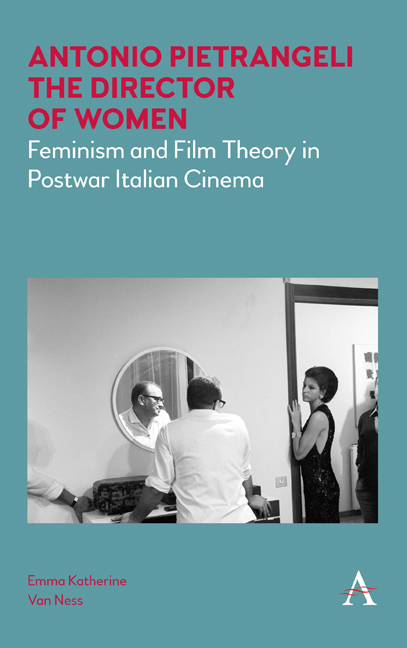Book contents
- Frontmatter
- Dedication
- Contents
- List of Illustrations
- Acknowledgments
- Vita
- Introduction: Antonio Pietrangeli, A Brief History
- Chapter 1 Pietrangelian Film Theory: From Neorealism to Feminism
- Chapter 2 Maid from the Margins: Il sole negli occhi
- Chapter 3 The Coming of Age of a Teenage Bride: Nata di marzo
- Chapter 4 Legally Bound: Political Realism and Prostitution in Adua e le compagne
- Chapter 5 Fantasmi a Roma: Sur-Realism and the Time-Image
- Chapter 6 The Dora Problem: La parmigiana, Piatti, Pietrangeli and Freud
- Chapter 7 Too Much Woman: Marriage, Power, and Excess in La visita
- Chapter 8 Breaking Faith: Il magnifico cornuto, Envy and the Crisis of Vision
- Chapter 9 Io la conoscevo bene … Or did I? Antonio Pietrangeli, the Author and the Actress
- Conclusion: Antonio Pietrangeli, Feminism and Film Theory
- Bibliography
- Index
Chapter 1 - Pietrangelian Film Theory: From Neorealism to Feminism
Published online by Cambridge University Press: 06 May 2020
- Frontmatter
- Dedication
- Contents
- List of Illustrations
- Acknowledgments
- Vita
- Introduction: Antonio Pietrangeli, A Brief History
- Chapter 1 Pietrangelian Film Theory: From Neorealism to Feminism
- Chapter 2 Maid from the Margins: Il sole negli occhi
- Chapter 3 The Coming of Age of a Teenage Bride: Nata di marzo
- Chapter 4 Legally Bound: Political Realism and Prostitution in Adua e le compagne
- Chapter 5 Fantasmi a Roma: Sur-Realism and the Time-Image
- Chapter 6 The Dora Problem: La parmigiana, Piatti, Pietrangeli and Freud
- Chapter 7 Too Much Woman: Marriage, Power, and Excess in La visita
- Chapter 8 Breaking Faith: Il magnifico cornuto, Envy and the Crisis of Vision
- Chapter 9 Io la conoscevo bene … Or did I? Antonio Pietrangeli, the Author and the Actress
- Conclusion: Antonio Pietrangeli, Feminism and Film Theory
- Bibliography
- Index
Summary
Spazzatura Americana— American Trash and Hollywood Cinema In the wake of the Second World War, Italy's film industry is drowning in imported Hollywood productions. American movies inundate the Italian market and dominate box offices, leaving the Communist intelligentsia and the film industry petitioning for protectionist measures to ensure the survival of an Italian national cinema. As a leftist film critic, Pietrangeli's writing was engaged in a cinematic resistance, a movement to limit foreign, chiefly American, film importation. His call for a new Italian cinema shares many of the same moral, ethical and political concerns as later feminist theory. Feminists have long taken issue with Hollywood and the representational conventions that this cinematic machine as studio system perennially churns out: happy endings, fixed gender roles and types and genre restrictions that allow little individual creativity on the part of filmmakers. Returns are king and the film is first a product; artistic considerations are a luxury. Kaja Silverman, for example, writes of classic cinema or the Hollywood film of the forties and fifties, that it “has the potential to reactivate the trauma of symbolic castration within the viewer, and that it puts sexual difference in place as a partial defense against trauma […] since it projects male lack onto female characters in the guise of anatomical deficiency or discursive inadequacy.” Hollywood, as Streep mentions above, has issues with how it represents women as commodities, sexual objects or secondary characters. Laura Mulvey also lambasts Hollywood, saying, “The magic of the Hollywood style at its best (and all of the cinema which fell within its sphere of influence) arose, not exclusively, but in one important aspect, from its skilled and satisfying manipulation of visual pleasure.” Pietrangeli was on the front lines of the battle in Italy that sought to produce an Italian national cinema, which brought audiences neorealism; auteur filmmakers such as Fellini, Antonioni, Pasolini and Bertolucci; as well as the popular cinema known as commedia all’italiana (comedy, Italian style), among other popular genres such as the peplum. Italian national cinema, for Pietrangeli, is resistance to the exploitative Hollywood model, the resistance to the expansion of this cinematic and cultural “Americanization” of Italy. In particular, Pietrangeli's modes of resistance in cinema are feminist ones.
- Type
- Chapter
- Information
- Antonio Pietrangeli, The Director of WomenFeminism and Film Theory in Postwar Italian Cinema, pp. 11 - 28Publisher: Anthem PressPrint publication year: 2020



